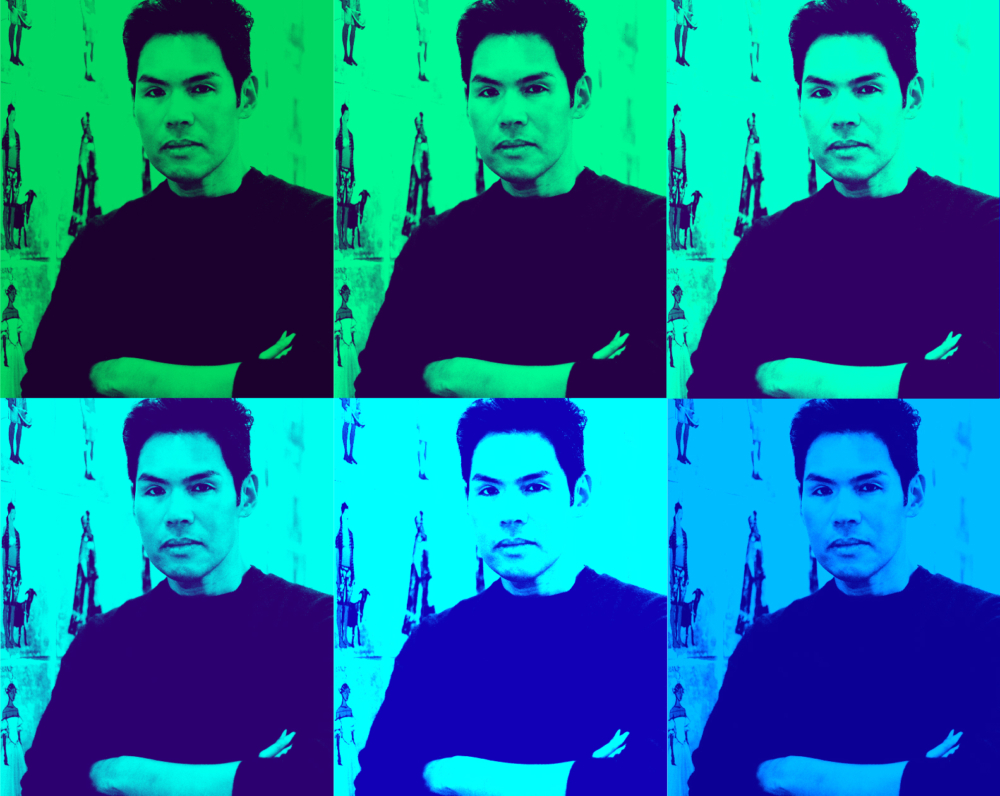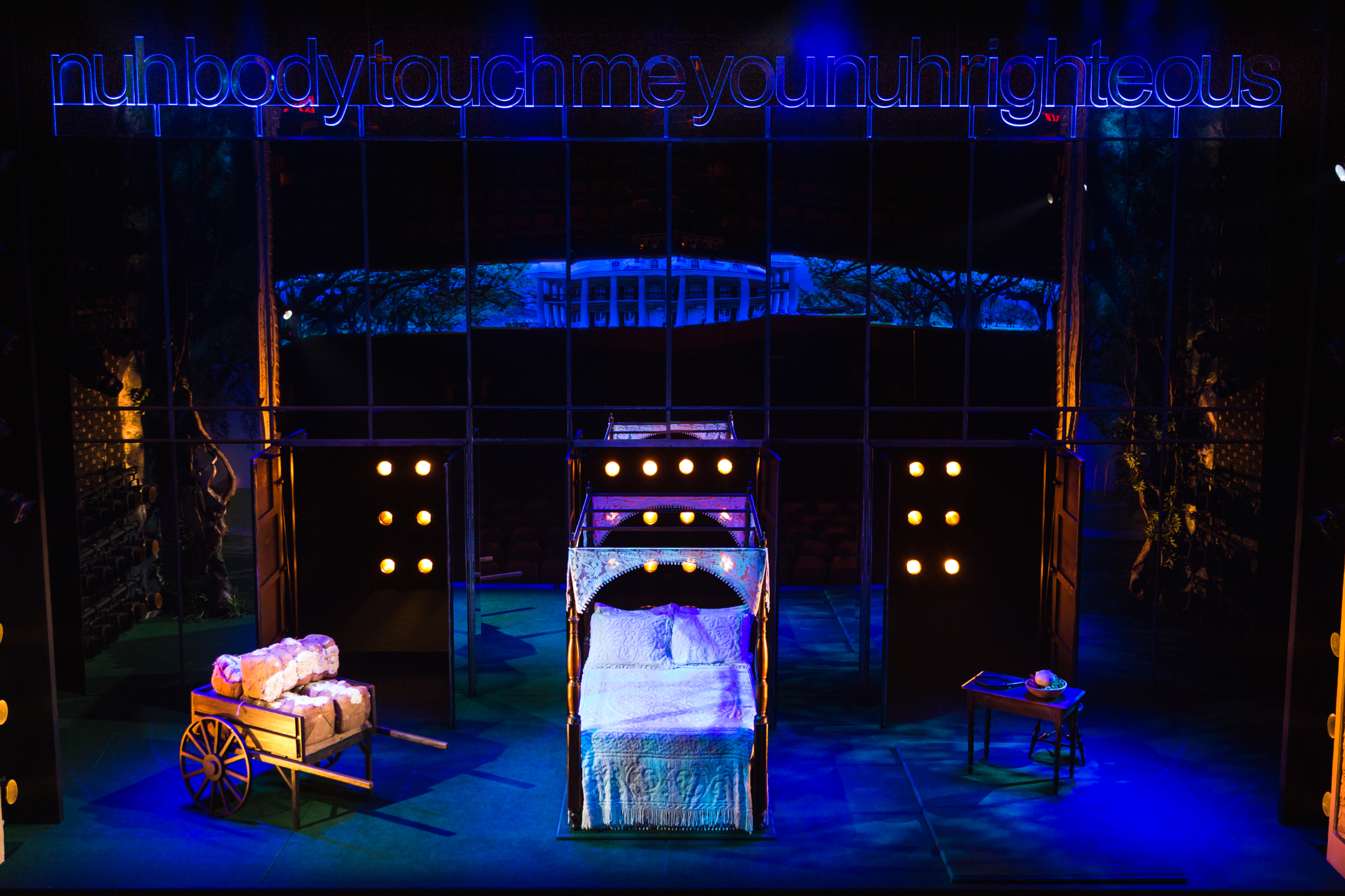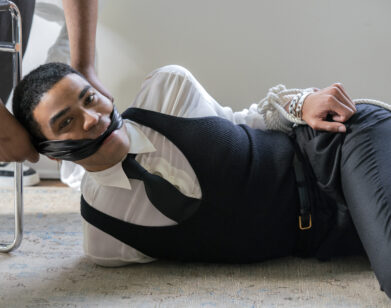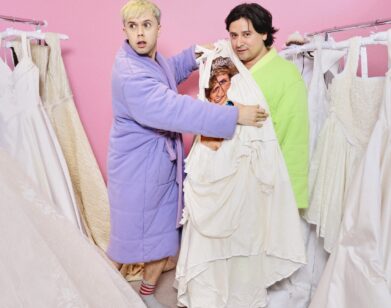Rihanna, Mirrors, and America: Processing Slave Play‘s Set Design

There’s a multitude of versions of our country: Black America. White America. Immigrant America. MAGA America. Queer America—the list goes on. Then there’s the America that Jeremy O. Harris spits at audiences with Slave Play, his Broadway meditation on sexuality, race, identity, and Rihanna. The America the playwright is serving—and straight out of Yale Drama, no less—is sexual, rude, alienating, shock-inspiring, sensual, and wounded—all while Bad Gal Riri’s “Work” plays in the background (loudly). The play focuses on three seemingly woke but messy interracial couples who are trying to reignite their flame of desire through a form of therapy that forces them to play out their innermost fears and fantasies in Antebellum America.
Although Slave Play is outrageous and provocative in plain sight, it’s the not-so-subtle undertones—whip-smart dialogue, therapyspeak satire, and innovative set design—have made the play the talk of the town. All of that came to life thanks to the creative partners behind Slave Play: director Robert O’Hara and Tony Award-winning set and costume designer Clint Ramos (among others). The trifecta behind Broadway’s most provocative resident spent hours nailing down their approach, which naturally became a highly personal project. “I’m a POC, I have a white husband. A lot of that plays into it, but I know not only did it land personally—I had to really locate where that pain was,” Ramos says. Tackling topics that seem to be tearing America at the seams—gender, white supremacy, fetishism, wokeness, not being black but also not being white—on a Broadway stage was not an easy task for Ramos, but it was a challenge he was more than willing to take on, even if it hurt. When audience members sit down to experience Slave Play, they are forced to face America and themselves, as the entire stage is covered in reflective surfaces, backlit only by the image of a plantation—a key feature for Harris, according to Ramos. The answer is nowhere to be found on stage; that’s not Slave Play‘s goal. Rather, as Ramos puts it, the goal is to get us to question our very own “colonized desires.” The play, as well as its set design, characters, and writing, proposes a deep inflection into our individual and communal relationship with this country. Below, the set designer helps us process Slave Play—and processes it himself. It’s a lot, so you better get to work, work, work.
———
ERNEST MACIAS: I’m excited to talk to you about this. I walked out of there like, “What did I just… What?”
CLINT RAMOS: I know what you mean. It’s a common occurrence.
MACIAS: I had a friend visit from L.A. and she was like, “What should I do that is so New York right now?” And I told her about Slave Play. She was blown away.
RAMOS: Is she white or POC?
MACIAS: She’s white.
RAMOS: It’s different, but also the same amount of shell shock. People walk out after seeing the play and think, “Fuck, I just got bamboozled by this thing.” I think also, as New Yorkers, but also just as Americans, there’s a very thin skin that covers this national anxiety around us, and it takes very little stimulus to pierce that skin, but that play literally ripped it open.
MACIAS: I think it’s one of those things that is hard to explain to people. Because it wasn’t the same experience for me as it was for her or the person sitting next to me that day. Tell me how you got into set design and costume design. Was this always what you wanted to do?
RAMOS: I was born and raised in the Philippines. I’d always been involved with theater in a very political way. My first introduction to theater was through street theater, basically like protests. I really saw the power of performance and what it could do as a catalyst for thought. I never really put two and two together, but I’ve always been attracted to the idea of how you can control a visual world and actually tell stories through that. Around college I understood that this was exactly what I could do with that proclivity, and I just pursued it. I’ve actually not done anything else, other than summer jobs or whatever. This has always been what I’ve done. I love designing for theater or for film. I just like creating stories through that medium.
MACIAS: It seems like you were influenced early on.
RAMOS: Very much so. It’s something that I take seriously. Clearly, as the years went by, I paid attention to what I was watching and what I was seeing. There’s something addictive about it, because I think part of our job requires us to go in and out of worlds and societies.
MACIAS: You do costume design, but you also do set design. What are the different challenges for each? Have you ever done both at the same time?
RAMOS: I’ve done it plenty of times. I have a movie on the festival circuit right now. It’s called Lingua Franca, which I did both the production design and the costume design. I did Eclipse on Broadway, and I did both set costumes that were for Lupita [Nyong’o]. It’s always about the person or that character. What is the world that he or she or they bump against? I could never separate both. I always have to think about the human being, and the world that that particular human being inhabits. With scenery, it’s really about capturing the physicalization of that emotional world, how it manifests itself physically. I think with clothing, it really is about psychology and sociology. “What did that person decide to put on that day to go about their day?” Craft-wise, it uses two different kinds of skills. With costume design, it’s a lot of interfacing with a human being—an actor. All of these choices need to seem organic to that character.
MACIAS: Slave Play encapsulates all of that. That’s a big dialogue. I felt like the set design for was almost another character in the play. Walk me through how you guys ended at what people are seeing on stage right now. It is interactive, but also stagnate at the same time. What were the conversations like in the beginning, and how did that lead to a whole wall of moving mirrors with Rihanna lyrics across it?
RAMOS: Oh my god. I’m so happy that you know that those are Rihanna lyrics.
MACIAS: You have no idea how long it took me.
RAMOS: I’m so happy that you got that. I work with Robert O’Hara a lot. We’ve done so many shows together. I adore him. I love his work and I feel like he’s such an important person in my creative life. He introduced me to Jeremy O. Harris, this young playwright who literally “won’t leave me alone,” he said. He sent me the script. I read it, and I was like, “Fuck. Robert, are you serious? What the fuck did I just read?” He was like, “I know, girl.” I fell in love with it. Have you ever seen that movie Requiem for A Dream?
MACIAS: Yes.
RAMOS: When I finished reading Slave Play, it’s exactly that feeling of a gut punch. I’m a POC, I have a white husband. A lot of that plays into it, but I know not only did it land personally, I had to really locate where that pain was. The dialogue with Jeremy and Robert—we all were coming at the play from different angles. Jeremy really wanted to make sure that there was… I remember this. He used the word “verisimilitude” in the plantation. He said, “I really want to make sure that we are on a plantation.” That conjured up a lot of things. Robert wanted to set it in the round, which is basically coliseum style. You’re looking at a performance in the middle, and the audience is around it. I think those two things were really the initial challenges. One of the research folders that I had was sexual practices and kink and fetishes. I really activated that, and then I started to fall in love with this idea, “How do you actually perform that in a performance context?” That’s where the mirror came. I looked at a lot of these bedroom ceiling mirrors where couples can watch themselves have sex. And then I thought, what if we actually do something where, not only are the couples watching themselves perform with each other but they’re also watching their own performance. Maybe we could make it big enough where we can watch the audience watch themselves watching this couple perform with each other.

Photo by Andrew Kluger.
MACIAS: Layers on layers.
RAMOS: Exactly. The audience is not invisible. In a way, that actually helped the actors who are performing these sexual acts feel more safe. It’s like, “No, we’re not performing for an anonymous group. We have faces to look at. We have faces who are complicit in this.” And then the next challenge was the plantation. I had this thought of, maybe we’d do something environmental where we’d create this black cage around the theater. That didn’t feel right. It occurred to me that there is this famous entryway to this Virginia plantation that we could look at. So I just really started looking at that portrait. First, on stage, and then knowing that I had mirrors, maybe I could reflect it with the audience. So in other words, it’s hovering over the audience. It’s this ghost. I loved this idea of this ghostly edifice that represents our national mortal sin, the original sin of this country, but actually not have the audience see it when they walk in. You see it through the reflection and you sit, but the moment you take your seat, you’re basically signing a contract: “Yes, I acknowledge that I have a part in this history, regardless of the generations that separate us from the original pact.” The Rihanna lyrics, to me, were the physicalization of the madness that hovered over the couples.
MACIAS: Why that specific song? It’s used from the beginning of the play. It’s the first thing that you interact with as an audience member.
RAMOS: That’s all Jeremy. He knew that “Work” was going to be it. He wrote it into the script. Rihanna‘s his muse. Clearly in act one they are “working,” and act two is pure psychology work. Act three is basically the result of that work, the exhaustion of that work. The idea of putting the lyrics on stage was my proposal to Jeremy and Robert. We literally were looking for the phrase that would mean something, but also not mean anything.
MACIAS: Were there any challenges in tackling a period piece in this modern way?
RAMOS: I think the challenge was giving it some flavor. In act one, we have a sense that we’re somehow in Antebellum America. I think that was, to me, getting the furniture right. We originally had a lot of props, but throughout the rehearsal period, Robert and I slowly took things away and distilled it to one iconic image, the one iconic piece of furniture: the bed, the desk, and the wheelbarrow for each of the couples.
MACIAS: How was it for you, as a POC, getting to exert your own creative vision over the Antebellum plantation era? Was it hard to tackle that and reshape it for a new generation?
RAMOS: People always gloss over that, especially for a POC. It cemented what I had already known about this country. Slave Play made me examine my own colonized desire. I moved to America in my teens. Most of the people I’ve dated or fallen in love with were white people—and I married a white person. It made me think about that relationship, and also think about, as a brown person: “Where do I fall in that white and black spectrum?” The white and black spectrum is a reality that all of us Americans really have to face. What is your relationship to the oppression of black people, and what is your relationship to white supremacy? It’s really a lot of that. I’m not black, but work with a lot of African-American people, and so I think there are a lot of things that I understand about their oppression because of my own personal experience with white supremacy, but I also know there’s a lot that I just could not possible know, because I’m not black. Part of designing this play is really about having empathy and compassion for human beings in general, but more importantly, to the ravages of history and looking at how we react today and, as Jeremy proposes, how slavery and racism have actually rejiggered our genetic code. If you’re from a culture or from a people who had a history of oppression, you will pass that on. I consider myself to be pretty woke, but up until working on Slave Play, we had to talk about this everyday. I have to say that as an artist and as a POC, it gave me another layer of awakening that I’ve never had.
MACIAS: I totally relate. As a person of color, I was watching that and I was like, “Well, I thought I knew things.” What do you think, with the set and the costumes and the play and the actors, what is the message that Slave Play is trying to give people as they leave the theater?
RAMOS: What we’re trying to do, and I believe what Jeremy and Robert are trying to do, is create this event as a venue for thought. Some people—they’ll polarize the actors to the play, but people are talking about it. People are talking about history and the legacy of slavery and racism. To me, it is about continuing that discussion, but also being unafraid to really question every single thing. There are a lot of woke people out there who think that they have nothing more to learn. We all know that that’s just not true, regardless of what color your skin is. I feel what Slave Play is trying to burst that bubble in a very rude way.
We are not going to be poetic or lyrical about this. We’re not going to mask it behind poetry—although his lines are really beautiful. This is a shared history. Regardless of whether you’re an immigrant, when you sign up to be in this country, you are signing up for all of that ugliness that this country did. That’s just the rule. To dance around that is futile. The message is: keep on fucking talking about it.






